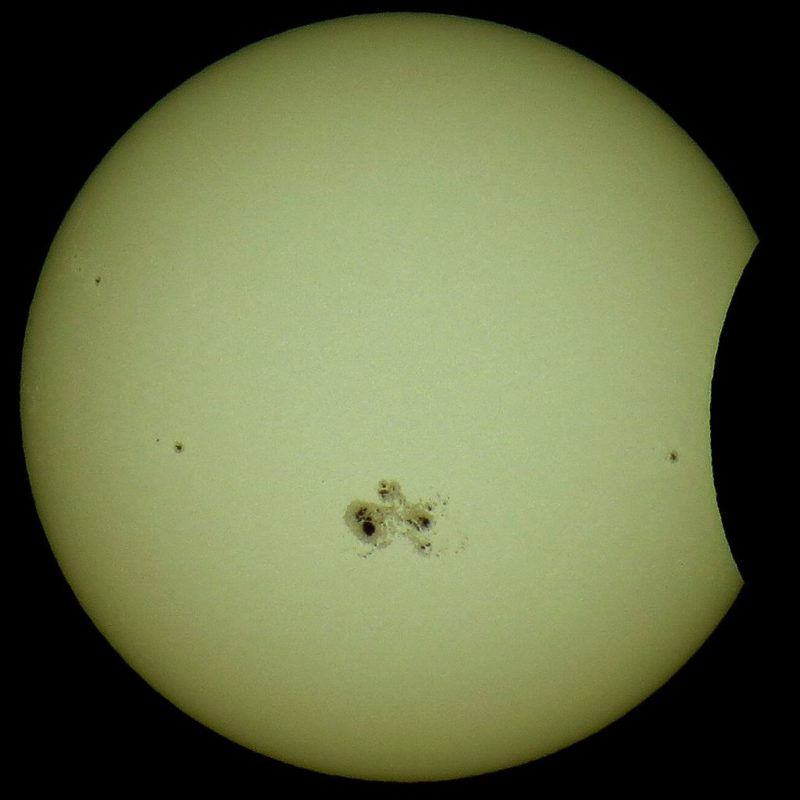
An imported image of the sun taken near the start of an eclipse Oct 23rd 2014. This is taken in white light (i.e. no coloured filters). A group of sunspots is clearly visible.
The Sun
The Sun is the star at the centre of the Solar System. It is a nearly perfect sphere of hot plasma, heated to incandescence by nuclear fusion reactions in its core, radiating the energy mainly as visible light, ultraviolet light, and infrared radiation. Its diameter is about 1.39 million kilometres (864,000 miles), or 109 times that of Earth. Its mass is about 330,000 times that of Earth; it accounts for about 99.86% of the total mass of the Solar System. Roughly three quarters of the Sun’s mass consists of hydrogen (~73%); the rest is mostly helium (~25%), with much smaller quantities of heavier elements, including oxygen, carbon, neon and iron.
The Sun’s core fuses about 600 million tons of hydrogen into helium every second, converting 4 million tons of matter into energy every second as a result. When hydrogen fusion in its core has diminished to the point at which the Sun is no longer in hydrostatic equilibrium, its core will undergo a marked increase in density and temperature while its outer layers expand, eventually transforming the Sun into a red giant. It is calculated that the Sun will become sufficiently large to engulf the current orbits of Mercury and Venus, and render Earth uninhabitable – but not for about five billion years.
The Photosphere
The visible surface of the Sun, the photosphere, is the layer below which the Sun becomes opaque to visible light. Photons produced in this layer escape the Sun through the transparent solar atmosphere above it and become sunlight. The photosphere is tens to hundreds of kilometers thick, and is slightly less opaque than air on Earth. Because the upper part of the photosphere is cooler than the lower part, an image of the Sun appears brighter in the center than on the edge or limb of the solar disk, in a phenomenon known as limb darkening.
Sunspots are temporary phenomena on the Sun’s photosphere that appear as spots darker than the surrounding areas. They are regions of reduced surface temperature caused by concentrations of magnetic field flux that inhibit convection. Sunspots usually appear in pairs of opposite magnetic polarity. Their number varies according to the approximately 11-year solar cycle. Individual sunspots or groups of sunspots may last anywhere from a few days to a few months, but eventually decay. Sunspots expand and contract as they move across the surface of the Sun, with diameters ranging from 16 km (10 mi) to 160,000 km (100,000 mi). Larger sunspots can be visible from Earth without the aid of a telescope.
Sunspots observed on successive days will appear in different positions due to the rotation of the sun. The period is around 38 days near the poles and about 25 days near the equator.
Click on the video above to see fading between the photosphere and chromosphere. Images were taken on 23rd March 2022.
The Chromosphere.
Many interesting phenomena can be observed in the chromosphere, which is very complex and dynamic:
Filaments (and prominences, which are filaments viewed from the side) underlie many coronal mass ejections (CME) and hence are important to the prediction of space weather. Solar prominences rise up through the chromosphere from the photosphere, sometimes reaching altitudes of 150,000 km. These gigantic plumes of gas are the most spectacular of solar phenomena, aside from the less frequent solar flares.
Prominences are anchored to the Sun’s surface in the photosphere, and extend outwards into the solar corona. While the corona consists of extremely hot ionized gases, known as plasma, which do not emit much visible light, prominences contain much cooler plasma, similar in composition to that of the chromosphere. The prominence plasma is typically a hundred times more luminous and dense than the coronal plasma.
The most common feature is the presence of spicules, long thin fingers of luminous gas which appear like the blades of a huge field of fiery grass growing upwards from the photosphere below. Spicules rise to the top of the chromosphere and then sink back down again over the course of about 10 minutes.
Imaging the Sun
The brightness of the sun means it MUST NOT be observed or imaged without special equipment.
1. The Chromosphere.
Without special equipment, the chromosphere cannot normally be seen due to the overwhelming brightness of the photosphere beneath. Most of light from the chromosphere is emitted by hydrogen atoms undergoing a particular atomic transition which emit a very narrow band of wavelengths. This is known as Hydrogen-alpha light. So to see the chromosphere the telescope is equipped with a special filter that only allows this narrow band of wavelengths.
2. The Photosphere.
This requires no special filter, but the intensity of the light must be seriously reduced! This is often done with a special diagonal (prism) called a Herschel Wedge. This reflects a very small proportion of the light at right angles whilst allowing the bulk to be diffracted almost directly through. They can get hot!